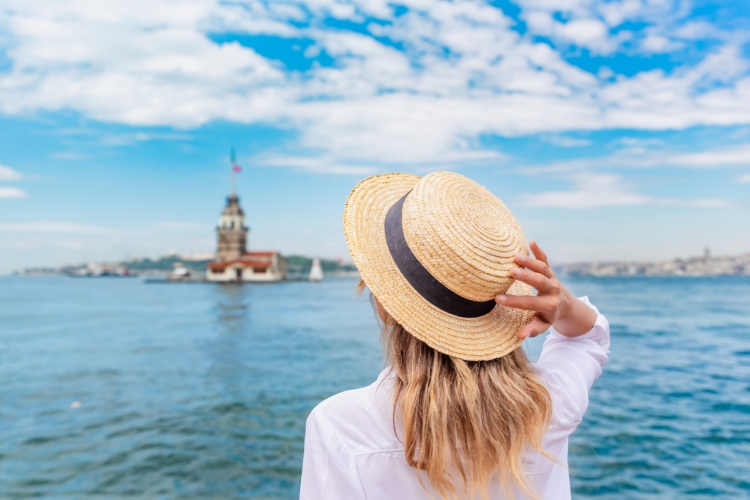Everything You Need to Discover About Hagia Sophia Mosque
Hagia Sophia Mosque, one of the most important structures that form the silhouette of Istanbul and has defied time by hosting many empires and states, is a masterpiece rising in the heart of the Historical Peninsula. This unique structure, which salutes the sky with its huge dome that is decorated with dazzling mosaics, offers a rich cultural heritage not only with its architectural splendor but also with the transformations it has undergone throughout history. Hagia Sophia Mosque, which has defied time in Sultanahmet Square for more than a thousand years, invites its visitors to open the doors of a world full of mystery while taking them on a journey into the past. Let’s examine everything that you need to discover about the Hagia Sophia Mosque together.
From the Great Church to Sacred Wisdom
Hagia Sophia Mosque, which was built by 10 thousand workers and 100 masters by the Byzantine Emperor Justinian I. between 532 and 537 AD, functioned as the largest church in the world for nearly a thousand years. The building, which was called the Great Church (Megale Ekklesia) when it was first built, was named Hagia Sophia (Sacred Wisdom) over time with the combination of the words Hagia (sacred) and Sophia (wisdom), as it was dedicated to Theia Sophia, the second element of the trinity belief in Christianity. Hagia Sophia, which was the center of the Orthodox world until the conquest of Istanbul, was converted into a mosque in 1453. The building, which was converted into a museum by the decision of the Council of Ministers dated 1935, gained mosque status again in 2020.
Columns and Marbles from Different Geographies
One of the things that makes Hagia Sophia so special is undoubtedly the type of materials that had been used and the geographies that they came from. During the construction of Hagia Sophia, upon the request of Justinian I., eight red porphyry columns were brought from Heliopolis, as in ancient Egyptian temples and marbles from the Temple of Artemis at Ephesus and Syria were used. Special bricks that were produced from Rodos soil were used to ensure that the dome was durable and had no chance of collapsing. An interesting feature of bricks was that they did not sink in water.
Emperor Door of the Rebel King León VI.
Although the Hagia Sophia Mosque has many doors, the most striking one is the Emperor Door, through which only kings can enter. There is a mosaic on the bronze-covered door, which is made of oak wood and is estimated to be 1500 years old. In this mosaic, León VI. is depicted prostrating in front of the figure of Christ. León married for the fourth time despite the church’s prohibition because he had married 3 women and had no sons. The mosaic here depicts the scene of León asking for forgiveness after being banned from entering the church.
The Wishing Column That Is Accompanying to Mary’s Tears
It is rumored that the wishing column in Hagia Sophia is the column of the tears of Mary’s that is melted and created a hole because of the news that Jesus was crucified and tortured. While Hagia Sophia was being built, it was specially brought, and the building was consecrated with this column. Visitors believe that their wishes will be granted if they put their fingers into the hole in this column, draw a circle and make a wish.
Sunu Mosaic from Hagia Sophia’s Iconic Mosaics
After entering the Hagia Sophia Mosque through the door known as the Beautiful Door, a unique mosaic welcomes you at the end of the corridor. In the middle of this unique mosaic, which was revealed during the restoration that was carried out in 1849, is Mary carrying Jesus in her arms, Justinian I. holding the map of the city on the right side and Constantine I, the founder of Istanbul, on the left side. It is told here that Justinian I. and Constantine presented both of them to Mary to protect the city and the church.
Tomb of Henricus Dandolo Is Located in Here
The tomb of Henricus Dandolo, whose life was the subject of novels and movies and who was in Istanbul during the Fourth Crusade, is located in Hagia Sophia. According to hearsays, Dandolo, who led the crusaders who invaded Istanbul at the age of 70, was blind. When he died in Istanbul during the invasion, he was buried inside Hagia Sophia, but the Byzantines exhumed his bones and threw them into the sea in 1261.
Pythagoreans Traces in the Deesis Mosaic
A new mosaic was made in Hagia Sophia in 1264. Although the figure of Jesus is depicted in this mosaic called Deesis, it is said that it does not actually exist. As proof of this, the scar on the right eyebrow of the Jesus figure is shown. The scar indicating the number eleven is attributed to Apollonius, a member of the Pythagoreanism. It is said that Pythagoreans who were forcibly converted to Christianity painted Apollonius instead of Jesus to take revenge.
Stay at Pera Palace Hotel While Exploring the Historical Peninsula of Istanbul
Have you ever thought of staying at Pera Palace Hotel while visiting the Historical Peninsula and Hagia Sophia Mosque, which has traces of history in every street? Close to the Historical Peninsula and located in the heart of Beyoğlu, Pera Palace Hotel offers you a perfect accommodation experience with its unique location, iconic structure, and 130 years of uninterrupted service.
Pera Palace Hotel, a building ahead of its time just like Hagia Sophia, carries the traces of the past to the present with its neo-classical structure, architectural details, Kubbeli Lounge, and world-famous guests that it hosts. You can relieve the tiredness of the day at Pera Palace Hotel while visiting Hagia Sophia, which was inherited from the Byzantines to the Ottomans and the Republic.
These articles may also be of interest to you:
Top 8 Museums You Must Visit in Istanbul
5 Historical Places That Continue to Host Their Guests Today


